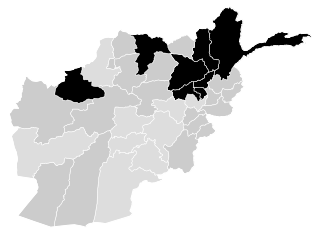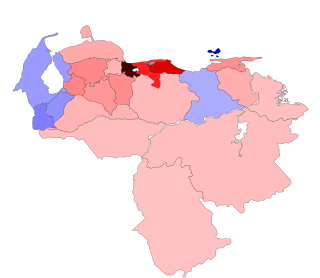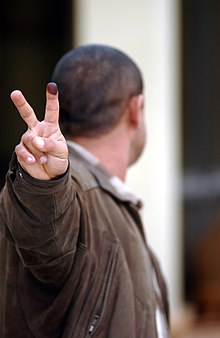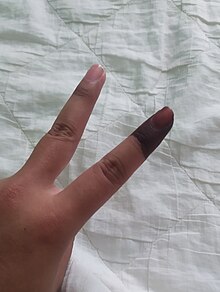
Ink is a gel, sol, or solution that contains at least one colorant, such as a dye or pigment, and is used to color a surface to produce an image, text, or design. Ink is used for drawing or writing with a pen, brush, reed pen, or quill. Thicker inks, in paste form, are used extensively in letterpress and lithographic printing.

Silver nitrate is an inorganic compound with chemical formula AgNO
3. It is a versatile precursor to many other silver compounds, such as those used in photography. It is far less sensitive to light than the halides. It was once called lunar caustic because silver was called luna by ancient alchemists who associated silver with the moon. In solid silver nitrate, the silver ions are three-coordinated in a trigonal planar arrangement.
Electoral fraud, sometimes referred to as election manipulation, voter fraud, or vote rigging, involves illegal interference with the process of an election, either by increasing the vote share of a favored candidate, depressing the vote share of rival candidates, or both. It differs from but often goes hand-in-hand with voter suppression. What exactly constitutes electoral fraud varies from country to country, though the goal is often election subversion.

A marker pen, fine liner, marking pen, felt-tip pen, felt pen, flowmarker, sign pen, vivid, flomaster, texta, sketch pen, koki or simply marker is a pen which has its own ink source and a tip made of porous, pressed fibers such as felt. A marker pen consists of a container and a core of an absorbent material that holds the ink. The upper part of the marker contains the nib that was made in earlier times of a hard felt material, and a cap to prevent the marker from drying out.

A permanent marker or indelible marker is a type of marker pen that is used to create permanent or semi-permanent writing on an object.

Presidential elections were held in Afghanistan on October 9, 2004. Hamid Karzai won the elections with 55.4% of the vote and three times more votes than any other candidate. Twelve candidates received less than 1% of the vote. It is estimated that more than three-quarters of Afghanistan's nearly 12 million registered voters cast ballots. The elections were overseen by the Joint Electoral Management Body, chaired by Zakim Shah and vice-chaired by Ray Kennedy, an American working for the United Nations.
Though Afghanistan has had democratic elections throughout the 20th century, the electoral institutions have varied as changes in the political regime have disrupted political continuity. Elections were last held under the Islamic Republic of Afghanistan, which was deposed by the Taliban in August 2021. The Taliban dissolved the Elections Commission in December 2021. In May 2022, when asked if the Taliban would hold elections, First Deputy Leader Sirajuddin Haqqani said the question was "premature". All political parties have been banned since August 2023.
India has a parliamentary system as defined by its constitution, with power distributed between the union government and the states. India's democracy is the largest democracy in the world.
Parliamentary elections were held in Afghanistan alongside provincial elections on 18 September 2005. Former warlords and their followers gained the majority of seats in both the lower house and the provincial council. Women won 28% of the seats in the lower house, six more than the 25% guaranteed in the 2004 constitution.

Martha Lupe Moyano Delgado is a Peruvian nurse, Fujimorist politician and a congresswoman representing Lima for the 2021–2026 term, previously serving in the 2000–2001, 2001–2006, and 2006-2011 terms. Moyano belongs to the Alliance for the Future party. She is the sister of María Elena Moyano, who was assassinated by Shining Path.
Mysore Paints and Varnish Limited, formerly Mysore Lac and Paints Limited, is a company located in the southern Indian city of Mysore, Karnataka. It is the only company in India authorised to produce indelible ink, which is used in elections to prevent people from voting multiple times. The company is currently owned and operated by the Government of Karnataka.

General elections were held in Malaysia on Saturday, 8 March 2008. Voting took place in all 222 parliamentary constituencies of Malaysia, each electing one Member of Parliament to the Dewan Rakyat, the dominant house of Parliament. State elections also took place in 505 state constituencies in 12 of the 13 states on the same day.

Presidential elections were held in Afghanistan on 20 August 2009. The election resulted in victory for incumbent Hamid Karzai, who received 49.67% of the vote, while his main rival Abdullah Abdullah finished second with 30.59% of the vote.

General elections were held in Malaysia on Sunday, 5 May 2013. Voting took place in all 222 parliamentary constituencies, each electing one MP to the Dewan Rakyat, the dominant house of Parliament. State elections also took place in 505 state constituencies in 12 of the 13 states on the same day. The elections were the first since Najib Razak became Prime Minister in 2009.
Parliamentary elections were held in Afghanistan on 18 September 2010 to elect members of the House of the People. The Afghan Independent Election Commission - established in accordance with the article 156 of the Constitution of Afghanistan for the purpose of organizing and supervising all elections in the country - postponed the poll from its original date of 22 May to September 18.

General elections were held in Cambodia on 28 July 2013. The National Election Committee (NEC) announced that some 9.67 million Cambodians were eligible to cast their ballots to elect the 123-seat National Assembly. Voter turnout was reported to be 69.6%, a record low for a general election. Polling precincts opened 7:00 a.m. and closed at 3:00 p.m. The Cambodian Minister of Information, Khieu Kanharith announced in preliminary results that the Cambodian People's Party won 68 seats and the opposition Cambodia National Rescue Party won all the remaining 55 seats. This election marked the largest seat loss by the Cambodian People's Party to date, and their lowest share of seats since 1998.

Presidential elections were held in Afghanistan on 5 April 2014, with a second round held on 14 June. Incumbent President Hamid Karzai was not eligible to run due to term limits. The registration period for presidential nominations was open from 16 September 2013 until 6 October 2013. A total of 27 candidates were confirmed to be running for office. However, on 22 October Afghanistan's Independent Election Commission disqualified 16 of the candidates, leaving only 11 in the race. By April 2014 three candidates gave up the race and decided to support some of the eight remaining candidates. Opinion polls showed Abdullah Abdullah and Ashraf Ghani as the front-runners and indeed the results of the first round of the election had Abdullah in the lead and Ghani behind him. The second set of results came after the run-off on 14 June, two months after the first round. Preliminary results were expected on 2 July and the final result on 22 July. However, widespread accusations of fraud delayed these results. As a result, John Kerry, then United States Secretary of State, mediated the negotiations between the two final candidates, Ghani and Abdullah. After a series of negotiations and talks between Ghani, Abdullah and Kerry, the two candidates agreed to sign an Agreement to form a National Unity Government based on 50–50 power sharing. As a result of that political agreement, a separate position was created for Abdullah as Chief Executive. The National Unity Government's term ran out after the next Afghan presidential election was held in September 2019.
Parliamentary elections were held in Afghanistan on Saturday 20 October 2018 to elect members of the House of the People. 3,296,643 people voted, 42% of registered voters. They had originally been scheduled for 15 October 2016, but were initially postponed to 7 July 2018, and then again to 20 October. Much of the prelude to the elections focused on the debate over reforming the country's electoral laws. The current system is one of single non-transferable vote. Kandahar's election was held on October 27. Polls were also delayed in Ghazni, due to an intensifying Taliban insurgency in the province, and as of September 2020 still have not been held. The new Parliament was inaugurated on 26 April 2019.

Regional elections were held in Venezuela on 15 October 2017 to elect the executive position of all 23 federal entities. This marked the first state executive election not held on the same date as elections for state legislatures, and the second separate from municipal elections. They were the 9th regional elections held in Venezuela since 1989.













